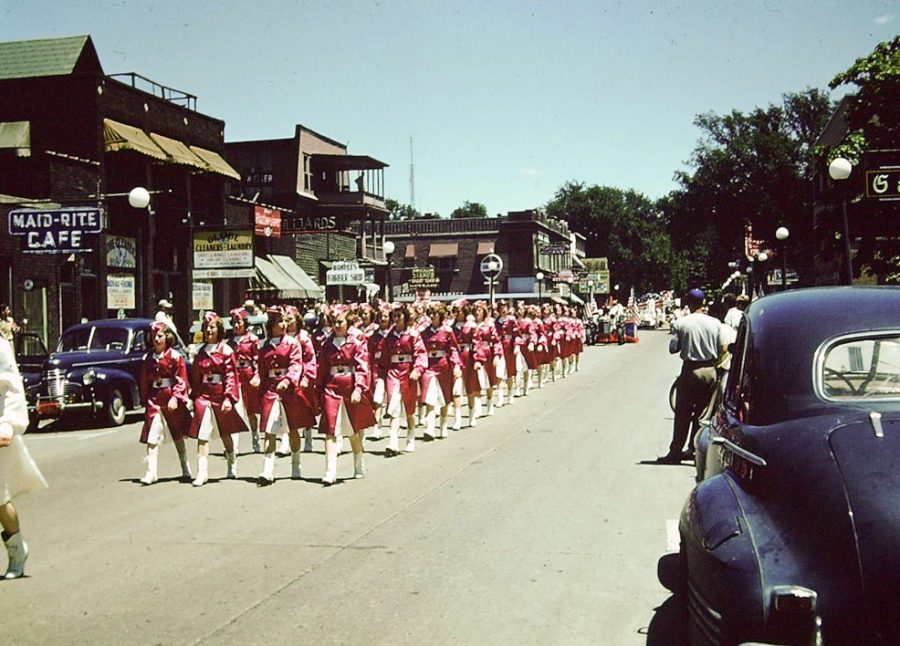Parades, protests, pool tables: A brief history of Green Street
Photo courtesy of Stephen Flynn
A parade passes through Green Street in the late ’40s. Stephen Flynn, class of ‘73, was born and raised in the C-U area with his family previously owning a bar on Green Street, The Deluxe.
July 22, 2022
Champaign and Urbana are two distinct cities; they have separate zip codes, separate atmospheres and separate downtowns. Yet, the University straddles these two towns, planting its feet in the middle and leaving its students and the businesses that cater to them to develop their own makeshift downtown. In comes Green Street.
Green Street has played its part in any University student or alum’s college experience. A backdrop for a late-night walk, the address of an apartment, a catch-all for a night out with bars and restaurants abound. The site of many protests, marches and parades — the heart of Campustown.
Throughout the University’s history, Green Street has evolved from a quaint hub of retail and commerce to a cosmopolitan-esque run of high-rise buildings and chain restaurants. To some, this reflects the changing demographics of a state university turned international, and to others it reflects the influence of big business and real estate.
For better or for worse, nearly everyone agrees that Green Street has changed.
—
Get The Daily Illini in your inbox!
Stephen Flynn, class of ’73, was born at Carle Hospital, delivered by one of the hospital’s founders. His mother was discharged from the hospital a few days after his birth, and the couple prepared to leave the hospital.
Before stopping home with their newborn child, they made an important stop — The Deluxe. The Deluxe was a bar on Green Street owned by Flynn’s family (Legends now stands where The Deluxe once stood). His father laid his child on a pool table for all his regular customers to see.
According to Flynn, The Deluxe was frequented by students from the College of Engineering and the College of Fine Arts, a hangout for self-described bohemians and intellectuals. In 1972, The Deluxe became the first Champaign establishment to obtain their outdoor liquor license. A local pioneer of the well-loved beer garden.
Flynn remained in Champaign-Urbana after graduation — periodically interrupted by stints in New Orleans, a city he loves — and saw Green Street develop throughout the years. To him, the ’70s to the early ’90s were the peak of Green Street culture.
“Throughout the 70s and mid 80s, it was so much fun,” Flynn said. “It was a very vibrant area. I liked it because — and I say this having lived in New Orleans — there’s so much pedestrian traffic. I drive through that area daily, even when the students are here, you don’t have the visibility of the students the way it was in the ’70s and ’80s and the early ’90s.”
Like any commerce hub, the layout of Green Street was perennially shifting. In the 1970s, around The Deluxe stood Bailey & Himes sporting goods, Jon’s Pipe Shop, a dry cleaner, two travel agencies and Art Mart. The only business that was part of a nationwide chain was a lone Taco Bell until a Wendy’s joined it.
Compared to today, very little remains on Green Street in terms of retail — only Target comes to mind. Flynn lamented this change, the loss of small retail shops signifying an overtake by big business.
“I’m not sure how we lost our way,” Flynn said. “We’re losing all our retail, kind of like every other downtown area.”
John Mies, a current Champaign resident, moved to Urbana in 1968 when he was 22 to be a student teacher at Urbana High School. Mies recalls his early days in the Champaign-Urbana area were marked by political unrest, with Green Street serving as a popular area for demonstrations.
“There were a lot of activists on campus,” Mies said. “It was interesting, I don’t know how else to explain it. Everybody was fighting for something, and some people didn’t even know what they were fighting for.”
On March 2, 1970, Green Street was transformed into a battleground when students took to the street to protest General Electric — a company that held defense contracts with the U.S. Department of Defense during the ongoing Vietnam War – actively recruiting on campus. According to a Daily Illini article, windows were smashed, rocks were thrown and eight individuals, both protesters and police, ended up in the hospital. 21 were arrested.
Although the businesses that line the street may have changed, its reputation as a center for protest has remained constant. In 2014, hundreds of students marched down Green Street in solidarity with Black Lives Matter protesters in Ferguson Missouri in the wake of the shooting of Michael Brown.
Throughout the summer and early fall of 2020, students and community members marched down Green Street to protest the murder of Georgy Floyd in solidarity with nationwide Black Lives Matter protests.
While student life has flourished on Green Street in terms of serving as a common place for protest and leisure alike, Flynn believes that the abundance of chain restaurants and a dwindling number of bars has lessened the street’s spirit.
“I hate to say it, but when I still visit the Wisconsin campustown in Madison and the one at Ohio State, their campustowns still have that wonderful cozy ‘I have a soul’ feeling,” Flynn said. “Green Street just does not have that any longer. It’s all grown up now, if you will. It’s all about business and not about the spirit or the soul of the community and the University.”







